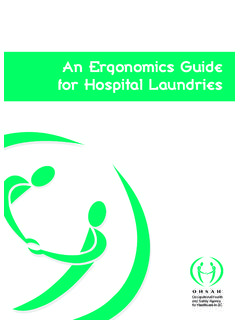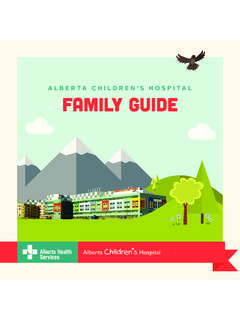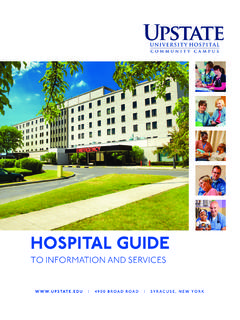Transcription of The guide to hospital data for non-executive directors - CHKS
1 The guide to hospital data for non-executive directorsSeptember in conjunction with2 The guide to hospital data for non-executive directors 3 The guide to hospital data for non-executive directors Understanding your organisation s 1: Activity, pathways and 2:Elective hospital admissions, waiting times and patient 3: A&E, non-elective admissions, readmissions and 4: How to make good use of data - quality and safety, including mortality, activity, contracting and guide to hospital data for non-executive directors 5 The guide to hospital data for non-executive directors Understanding your organisation s data is an essential part of providing effective oversight. But data may not always give you the complete picture and it is important to first understand what data is available, how it is recorded and what these records are used guide will help non-executive directors (NEDs) better understand NHS data and how it can be used to determine what is going on in their hospital .
2 For the purposes of this Briefing we examine data in the acute care setting only. data is of course collected in primary care by GPs, pharmacists, dentists and opticians, but the various datasets are not linked by the your organisation s data6 The guide to hospital data for non-executive directors 7 The guide to hospital data for non-executive directors Part one introduces the scale of NHS activity, the range of activity, the patient pathway and the major points1. Detailed data is collected on service deliveries that take place in NHS hospitals in England. This data may be analysed by patient pathway stage, by speciality, by treatment provided, or by disease and treatment There are a variety of data sources available to NEDs including the hospital s patient administration system and the NHS Choose and Book Analysis of data can provide valuable insights into forecasting service demand, and identifying how to better match capacity to demand by tackling issues like patient non-attendance or appointment rescheduling.
3 Part one: Activity, pathways and datasets8 The guide to hospital data for non-executive directors In England there are more than 70 million outpatient attendances and 15 million hospital admissions a year. An analysis of the total volume of hospital admissions reveals that two million of these relate to maternity services and babies, eight million are elective and five million are emergency of the admissions data reveals that the proportion of the population admitted to hospital increases with age; nearly two-thirds of patients admitted to hospital are over the age of 65 and the likelihood of admission is greater for older people 83 per cent of people over 85 years of age will be admitted to hospital (see Figures 1 to 3).
4 The scale of hospital activity Figure 1. Proportion of age band admitted to hospitalFigure 2. Number of outpatient attendances by ageFigure 3. Admissions to hospital by age9 The guide to hospital data for non-executive directors An extensive range of services are delivered in secondary care. These hospital services can be differentiated in five ways: by the stage on the patient s pathway outpatient, diagnostics, daycase or inpatient by speciality, based on the age of the patient for example, birth (obstetrics), childhood (paediatrics) and care of the elderly (geriatrics) by specialty, based on the part of the body that has the problem which is then further categorised as a surgical or medical (non-surgical) case by treatment provided by other health professionals for example, physiotherapy, speech therapy, dietetics by disease, and the treatment services which support this clinical work include.
5 Hotel services providing food, cleaning and portering technical support for example, medical physics, maintaining diagnostic and treatment equipment and ensuring that it delivers the correct dosages; and IT departments estates (or building) services, looking after the provision of power and water, building maintenance and heating administration the management of patient appointments which includes recording data about a patient s hospital contact, coding their treatment into agreed classifications, and the distribution of letters to GPs informing them of what is happening to their range of hospital activityKey questions for NEDs to ask How often does your trust cancel and re-arrange outpatient appointments?
6 What is the rate of hospital cancellation by specialty? What is your policy for did not attends (DNAs) does this feel appropriate for your population? How many coders does your trust have and are they qualified? Is your trust able to consistently recruit qualified coders? What internal auditing is done on the accuracy of coding? How aware are doctors within your trust of the importance of the source documents to accurate coding?10 The guide to hospital data for non-executive directors This report reviews the standard patient pathways for adults admitted to a admissionsA patient makes an appointment at a GP practice. The doctor carries out an initial examination and possibly some tests before referring the patient to a named consultant.
7 The patient then attends the hospital as an outpatient for an appointment with that consultant. One of the outcomes of this consultation could be a procedure (operation). When the patient is admitted to hospital for the procedure, it is classed as an elective admission because the patient has chosen (or elected) to have the procedure. Elective admissions currently make up around 50 per cent of all hospital admissions and include orthopaedic procedures, such as hip replacement. However, as the majority of elective procedures are now carried out as day cases (no overnight stay required) these constitute a smaller proportion of bed admissionsThe largest proportion of hospital occupants are emergency admissions.
8 The manner in which patients are admitted through the front door of a hospital as an emergency case will vary from hospital to hospital . Some hospitals only have an A&E department, and patients are admitted straight onto wards from there. Many hospitals, however, now have special admitting units which can cover all emergency patients and are often split between medicine and surgery. These are known variously as clinical decisions units (CDUs), acute medical units (AMUs) and medical and/or surgical admissions common example of a surgical admission is a patient with severe abdominal pain who has been sent in as an emergency by their example of an emergency medical admission is an elderly patient with a urinary tract infection.
9 In the elderly these infections can be debilitating and such patients are often described as being off legs . With an elderly individual, the admission may have resulted following a phone call from a carer or a data perspective, there is no seamless linkage between the primary care data sets and that generated by hospitals. Within the secondary care setting itself, the use of three separate data sets within hospitals can make tracking the patient pathway from beginning to end a standard patient pathways for adults admitted to a hospital11 The guide to hospital data for non-executive directors The data recording system in use in hospitals today was set up prior to the introduction of Payment by Results (PbR).
10 Despite the fact that the data that underpins hospital income (as defined by PbR) has become a business-critical issue, the way that clinical information is recorded has not the present time three major datasets are recorded in a hospital : data for outpatients data specific to A&E data for admitted three datasets have a certain amount in common all record personal information, basic administrative details and some clinical information. The administrative details will include the patient s personal information and the date of contact with the data is captured in a patient administration system (PAS) which contains the three unlinked data sets. The information in the PAS is published centrally (in a patient-anonymised form) by the Health and Social Care Information Centre as the hospital Episode Statistics (HES) records the data ?







